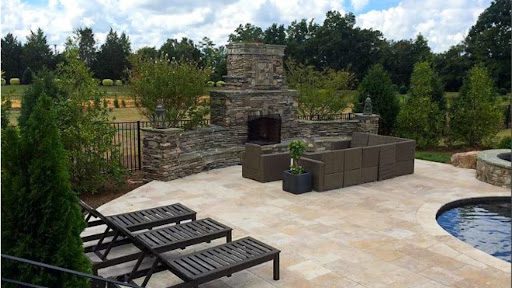Outdoor landscape lighting should be placed strategically to highlight key features, such as pathways, trees, and architectural elements, while ensuring safety and enhancing the overall ambiance of the outdoor space. From illuminating pathways to accentuating architectural elements, thoughtful lighting can make a significant difference in how your garden is experienced after dark.
At Regal Landscapes, we leverage over 22 years of experience in landscaping to craft visually striking and functional outdoor lighting solutions tailored to the unique needs of the Charlotte area. Discover how to optimize your outdoor spaces with our expert tips on landscape lighting placement.
Key Takeaways
- Illuminate pathways and walkways for safety and aesthetics.
- Use uplighting to highlight trees and shrubs for dramatic effects.
- Enhance outdoor living areas with ambient lighting for a cozy feel.
- Highlight architectural features to increase curb appeal.
- Accentuate water features and artwork with targeted lighting.
- Ensure entryways and driveways are well-lit for safety and guidance.
- Layer different types of lighting to add depth and dimension.
- Choose energy-efficient options to reduce costs and environmental impact.
Key Locations for Landscape Lighting
Pathways and Walkways
Illuminate paths with low-level fixtures for safe navigation. Avoid placing lights in a straight line; instead, stagger them to add visual interest and create a welcoming ambiance.
Trees and Plants
Use uplighting to highlight trees and shrubs, creating dramatic silhouettes. Soft lighting for flower beds can enhance their beauty and add depth to your garden.
Outdoor Living Areas
Enhance patios, decks, and pergolas with ambient lighting. Options include hanging string lights or wall-mounted fixtures to create a cozy atmosphere for gatherings.
Architectural Features
Highlight your home’s architectural details, such as columns and facades, using grazing or washing techniques. This not only adds elegance but also increases curb appeal.
Water Features
Accentuate ponds, fountains, or waterfalls with underwater lighting to create captivating visual effects that draw attention to these focal points.
Statues and Artwork
Use spotlights to illuminate sculptures and garden art, transforming your outdoor space into an art gallery at night.
Front Porch and Entryways
Ensure your entry points are well-lit for safety and to welcome guests. A well-lit front door enhances security and visibility.
Driveways and Garages
Use low-voltage spread lights along the edges of driveways to guide visitors without overwhelming the area with light.
Considerations for Effective Lighting
- Focus Points: Identify and highlight key features in your landscape to create visual interest and guide the eye.
- Layered Lighting: Combine different types of lighting (ambient, task, and accent) to create depth and dimension in your outdoor space.
- Energy Efficiency: Opt for LED bulbs and consider using timers or motion sensors to reduce energy consumption while maintaining effective lighting.
- Avoid Overlighting: Be mindful not to cluster too many fixtures in one area, which can detract from the overall effect and create glare.
By strategically placing landscape lighting, you can enhance the beauty and functionality of your outdoor areas, creating inviting spaces that are safe and visually appealing after dark.
Essential Guide to Outdoor Landscape Lighting:
1. The Benefits of Outdoor Lighting for Security
Outdoor lighting enhances both the aesthetics and security of your property. Well-placed lights can deter intruders, illuminate dark areas, and ensure safe navigation around your home. Motion-activated lights add an extra layer of security by alerting you to movement and startling potential intruders.
- Deters Intruders: Visible lighting reduces the likelihood of break-ins.
- Illuminates Dark Corners: Provides clear visibility in previously dark areas.
- Motion-Activated Lights: Alerts you to movement and deters intruders.
- Safe Navigation: Well-lit pathways and driveways enhance safety for residents and guests.
2. How to Choose the Right Landscape Lighting Fixtures
Choosing the right landscape lighting fixtures involves balancing functionality, aesthetics, and energy efficiency. Consider the size of your space, features to highlight, and personal style when selecting fixtures. LED lights are a popular choice for their efficiency and longevity.
- Fixture Types: Spotlights, floodlights, path lights, and wall-mounted fixtures.
- Energy Efficiency: LED lights are cost-effective and long-lasting.
- Lighting Effects: Choose between soft, ambient glow or bright, focused beams.
- Space and Style: Match fixtures to the size of your space and desired look.
3. Maintenance Tips for Outdoor Lighting Systems
Regular maintenance is key to keeping your outdoor lighting system in optimal condition. Routine cleaning, bulb checks, and seasonal inspections can prevent issues and ensure your lights function effectively. Trimming foliage around fixtures also helps maintain proper illumination.
- Cleaning: Remove dirt and debris from fixtures regularly.
- Bulb Checks: Replace damaged or burned-out bulbs promptly.
- Wiring and Connections: Ensure they are secure and undamaged.
- Seasonal Inspections: Identify and address potential issues early.
- Foliage Trimming: Prevents light blockage and maintains effectiveness.
Frequently Asked Questions About Landscape Lighting
- How do you zone landscape lighting?
Zoning landscape lighting means dividing your space into areas with specific lighting needs. Identify zones like pathways or seating areas, choose suitable fixtures for each, adjust brightness as needed, and use separate circuits or smart controls for tailored lighting effects.
- How do you position landscape lights on trees?
Position uplights at the base of trees, angling them upward to illuminate the trunk and canopy. For a more dramatic effect, use downlights installed in the branches to cast light downward or create silhouettes.
- How far apart should I place landscape lights?
Pathway lights should be spaced about 6 to 8 feet apart to ensure even illumination. For other types of lighting, such as those highlighting features or trees, placement distance varies based on the desired effect and the intensity of the light.
- What is the maximum distance for landscape lighting?
The maximum distance between landscape lights depends on the type and brightness of the fixture. Generally, for pathway lights, keep them within 8 feet apart. For spotlights and other accent lights, distances can vary but should ensure adequate coverage and avoid dark spots.
- What color of light is best for landscape lighting?
Warm white light (2700K) is typically best for landscape lighting as it creates a welcoming, natural look. Cool white light (5000K) can be used for a more modern, crisp appearance, but it may not be as flattering for outdoor settings.
Illuminate Your Outdoor Spaces with Regal Landscapes
Transform your outdoor areas into stunning nighttime settings with expert landscape lighting from Regal Landscapes. Our 22 years of experience in landscaping ensure that your home’s beauty is highlighted while enhancing safety and functionality. Whether you want to accentuate architectural features or create a cozy atmosphere for evening gatherings, we have the knowledge and skills to bring your vision to life.
Contact us now at Regal Landscapes to schedule a consultation and discover how our expert team can illuminate your yard with style and precision. We’re here to provide tailored lighting solutions that match your needs and preferences.




